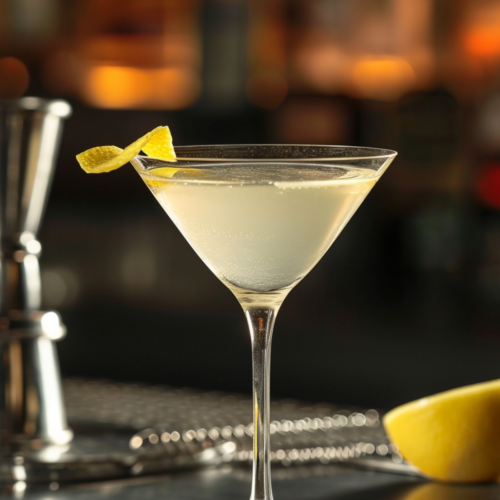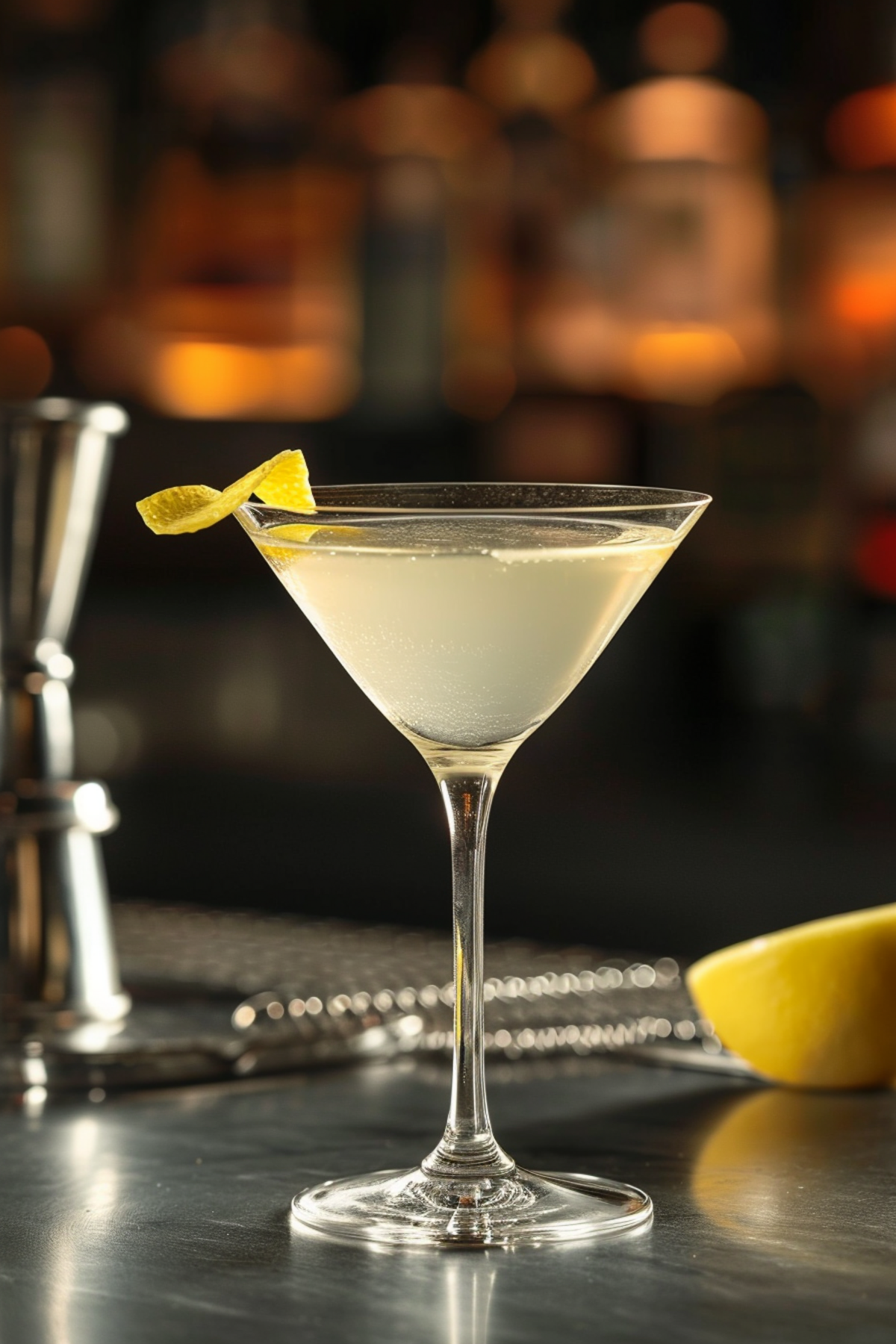Discover the Exquisite Pisco Martini: A South American Twist on a Classic
Imagine the crisp, refreshing zing of a classic martini, but with a South American soul. That’s the essence of a Pisco Martini. This cocktail seamlessly blends the aromatic complexity of pisco with the dry vermouth’s subtle herbal notes, creating a drink that’s both familiar and exotic.
Whether you’re lounging on a sun-drenched patio or hosting an elegant soiree, the Pisco Martini is versatile, catering to any occasion. But what makes it truly stand out? Perhaps it’s the way the pisco’s grape-based character dances with the vermouth, or maybe it’s the cocktail’s storied past that adds to its allure.
Are you ready to elevate your cocktail game with a sophisticated yet simple concoction? Let’s dive into the world of Pisco Martinis and discover why this drink is more than just a cocktail—it’s an experience.
Key Facts:
- Alcohol Content: 24% ABV
- Calories: Approximately 150
- Glass Type: Martini Glass
- Typical Garnish: Lemon Twist or Olive

Tasting Notes: A Symphony of Flavors in a Glass
The Pisco Martini is not just a drink; it’s a symphony of flavors waiting to be savored. The first sip introduces a bright, grape-forward note from the pisco, which is then enveloped by the dry vermouth’s crisp, herbaceous qualities. The result is a cocktail that’s both bold and refined.
Connoisseurs of nuanced spirits will appreciate the Pisco Martini’s balance and depth. It’s a perfect choice for those who enjoy a dry martini but are looking for something with a bit more personality. Whether it’s a celebratory toast or a contemplative nightcap, this cocktail fits seamlessly into any setting.
And for those who love a good story with their sip, the Pisco Martini has plenty to tell. Each ingredient carries its own history, contributing to a drink that’s as rich in narrative as it is in taste.
The Fascinating History of the Pisco Martini
The origins of the Pisco Martini are as intriguing as the drink itself. Pisco, a grape brandy that hails from the winemaking regions of Peru and Chile, is the star of this cocktail. It’s a spirit with a history that dates back to the 16th century when Spanish settlers brought the art of distillation to South America.
Fast forward to the early 20th century, and the Pisco Sour, pisco’s most famous cocktail, was born. But it wasn’t until adventurous bartenders began experimenting with pisco in other classic cocktails that the Pisco Martini emerged as a sophisticated alternative to its gin and vodka-based relatives.
Today, the Pisco Martini is a testament to the spirit of innovation that defines the world of mixology. It’s a cocktail that honors its roots while embracing the ever-evolving landscape of global flavors.
Ingredients: Crafting the Perfect Pisco Martini
- Pisco: The soul of the cocktail, pisco brings a fruity and floral bouquet that sets the Pisco Martini apart.
- Dry Vermouth: This fortified wine adds a layer of complexity with its herbal and slightly bitter profile.
- Ice Cubes: Essential for chilling and diluting the cocktail to perfection.
- Garnish: A lemon twist adds a zesty aroma, while an olive brings a touch of savory contrast.
Did you know? The Pisco Martini is not only about taste but also about texture. The stirring method used in its preparation ensures a silky smooth sip every time.

The Basic Method: Stirring Up Perfection
To craft the perfect Pisco Martini, start by filling a mixing glass with ice cubes. This will ensure that your cocktail is chilled to the ideal temperature.
Next, pour the pisco and dry vermouth over the ice. The ratio is crucial here; too much vermouth can overpower the pisco, while too little won’t give the cocktail the complexity it deserves.
Stir the mixture for about 30 seconds. This not only chills the drink but also dilutes it slightly, which is essential for softening the alcohol’s bite and allowing the flavors to meld beautifully.
Once stirred to perfection, strain the mixture into a chilled martini glass. The temperature of the glass is just as important as the drink itself, as it keeps the cocktail crisp from the first sip to the last.
Finally, garnish with a lemon twist or an olive, depending on your preference. The garnish is more than just decoration; it’s a final flourish that can subtly alter the drink’s aroma and taste.
Serving Suggestion: Presentation Meets Taste
The Pisco Martini is best served in a classic martini glass. The iconic shape not only adds to the aesthetic but also allows the aromas to concentrate at the surface, enhancing the overall sensory experience.
When it comes to garnishes, a lemon twist is traditional. The oils from the lemon peel add a fresh, citrusy aroma that complements the pisco’s grape notes. For a more savory option, an olive can provide a briny counterpoint to the cocktail’s dryness.
Elevating the Cocktail: Tips from a Mixologist
- Quality Pisco: Choose a high-quality pisco for the best flavor. The brand and region can greatly influence the cocktail’s taste profile.
- Chill Your Glass: Store your martini glass in the freezer before serving to keep your Pisco Martini cold longer.
- Experiment with Bitters: A dash of orange or aromatic bitters can add another layer of complexity to the cocktail.

Substitutions and Alternatives: Tailoring to Your Taste
If you find yourself without dry vermouth, a splash of white wine can be a suitable substitute, although the flavor will be less complex. For those who prefer a sweeter profile, a dollop of simple syrup can round out the sharpness of the pisco.
Similar cocktails that share the Pisco Martini’s spirit include the classic Pisco Sour or the Chilcano, which offers a more casual, effervescent take on the grape brandy.
Add a Twist: Creative Variations on the Classic
For a modern take on the Pisco Martini, consider infusing your pisco with herbs or botanicals. Lavender or rosemary can introduce a floral or woody dimension that’s both surprising and delightful.
Another variation is to swap out the dry vermouth for a flavored one, such as Lillet Blanc or a fortified wine like Cocchi Americano. These can add a subtle sweetness or a bitter edge, depending on your preference.
Preferred Liquors: The Foundation of Flavor
When it comes to selecting a pisco, brands like Pisco Portón or Barsol are renowned for their quality and can elevate your cocktail to new heights. These producers offer a range of piscos that vary from the crisp and clean to the rich and aromatic, giving you plenty of options for crafting your perfect Pisco Martini.
Frequently Asked Questions
Can I shake the Pisco Martini instead of stirring? While shaking can chill the cocktail faster, stirring is preferred for a smoother texture without the air bubbles that shaking introduces.
Is there a difference between Peruvian and Chilean pisco? Yes, each country’s pisco has distinct characteristics based on grape variety and production methods, which can affect the cocktail’s final flavor.
How can I make my Pisco Martini less dry? Adjust the vermouth ratio or add a touch of simple syrup to soften the dryness to your liking.
What’s the best way to garnish a Pisco Martini? A lemon twist is classic, but feel free to experiment with olives or even a cocktail onion for a Gibson twist.
Can I use any type of vermouth? While dry vermouth is traditional, experimenting with different vermouths can lead to interesting variations on the classic Pisco Martini.

Pisco Martini
Equipment
- Mixing glass
- Bar spoon
- Strainer
- Martini glass
Ingredients
- 2 oz Pisco
- 1 oz Dry Vermouth
- Ice cubes
- Lemon twist or olive for garnish
Instructions
- Fill a mixing glass with ice cubes.
- Pour the pisco and dry vermouth over the ice.
- Stir the mixture for about 30 seconds to chill and dilute the drink slightly.
- Strain the mixture into a chilled martini glass.
- Garnish with a lemon twist or an olive.

